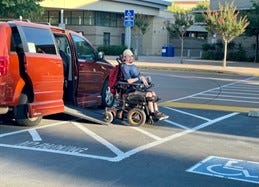Access Angle: Accessible Parking Spaces
- Jul 8, 2021
- 0 Comments


Gabriel Ryan, School Health Blog Writer and Contributor
Accessible Parking Spaces: “I’ll just park here for a minute!”
As businesses are re-opening across the country and people are increasing their activities throughout the day in the community, keep in mind that where you park matters. Parking in handicapped/accessible parking spaces with the International Symbol of Accessibility and without a valid disabled parking placard, disabled license plate, or if you are blocking access aisles (striped cross-hatched areas next to disabled space) can impact your wallet as well as create hurdles for people with disabilities. Sometimes people think, “I’ll just park here for a minute,” but that minute could turn into an expensive parking ticket! These tickets can potentially cost thousands of dollars and in some states the penalty can result in a suspended or revoked driver’s license.
Did you know that handicapped parking regulations are a part of the Americans with Disabilities Act (ADA), which was signed into law by President George H.W. Bush on July 26, 1990? Bush described the law as, "the world's first comprehensive declaration of the equality of people with disabilities.” The ADA, Section 4.6, “Parking and Passenger Loading Zones” details the federal requirements as having designated parking within the shortest accessible route of travel to an accessible facility entrance.


Why does it matter?
Access to accessible parking spaces can be critical for members of our communities with disabilities who may not otherwise be able to easily gain entry to a business or venue. The distance between the parking area and the entrance is not the only reason these spaces are important for many people who rely on them. Often, the extra room in the access aisles provides the needed space to unload equipment such as walkers and wheelchairs or to completely open the doors for entering and exiting the vehicle. When these parking spaces are occupied, people who need the extra clearance to unload/exit the vehicle are left with the choice to find two consecutive open spaces, unload in a potentially busy high-traffic area or uneven surface, and sometimes leave the business or venue altogether and try again another day, if possible.
Realizing that not everyone has seen how these accessible spaces are utilized by people who use wheelchairs, I decided to create a short video clip to demonstrate how I use the van accessible parking space. My van has a ramp that extends to just under four feet from the passenger side of the vehicle when deployed. Notice how the access aisle provides just enough space to maneuver onto the ramp. This video example shows how this space allows room to safely navigate entering and exiting a vehicle. It is common to see delivery trucks, cars, and motorcycles obstructing the access aisles. The number one item randomly placed in the access aisle or accessible parking space is the shopping cart. This may be from someone just not wanting to put the cart back where it goes, or it may have been left by someone with a disability not able to return the cart. Either way, obstacles like these could pose a risk or hazard, which could lead to catastrophic damage or injury.
Spread the word:
· Accessible parking spaces are reserved only for those with valid placards and plates. Remember, the person with the disability must be in the vehicle.
· Obstructions in the access aisle create barriers for people with disabilities.
· Do your part, take back the cart! Return shopping carts to the store or cart return area if you are able to.
Accessible parking spaces are just one part of the extensive Americans with Disabilities Act Federal civil right law. For more information check out the Americans with Disabilities Act – ADA Update: A Primer for State and Local Governments publication.
